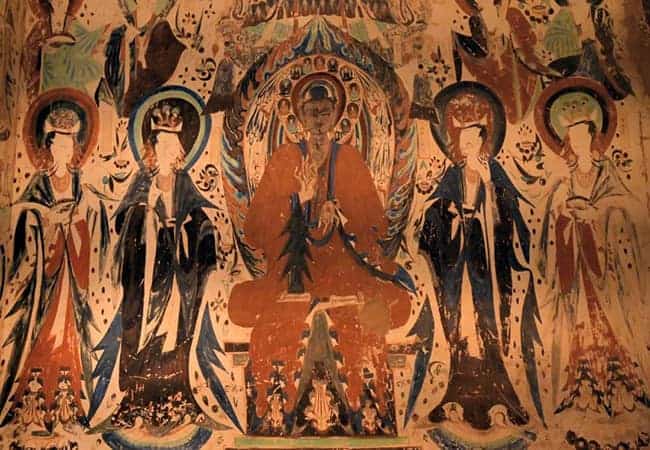Look deep into the World Heritage Site in the Off-season
Travelers always tend to avoid visiting the great Northwest in winter since they believe it is desolation in this period. But we want to tell you that when you come to Gansu during the off-season to visit the grottoes, you will not only have discounted tickets and no worry about being crowded, but also can visit more caves.
Today, CXT intends to take you around the three major grottoes in Gansu, and experience the mysterious and charming grotto culture.
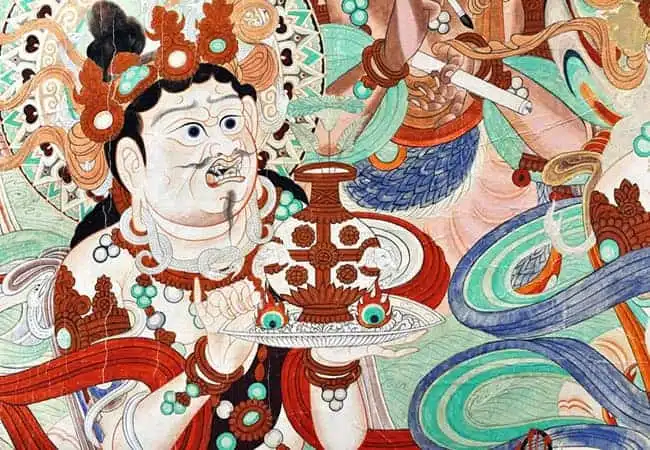
The terrain of Gansu is like a Ruyi(an S-shaped ornamental object, made of jade, formerly a symbol of good luck). At the western end of Ruyi, Mogao Grottoes, Yulin Grottoes, East and West Thousand Buddha Caves, Five-Temple Grottoes, and Changma Grottoes form a large-scale Dunhuang grotto group. At the eastern end of Ruyi, it is The Longdong Grottoes led by the Maijishan Grottoes, and the slender handle is the Hexi Corridor, scattered with Wenshu Mountain Grottoes, Matisi Grottoes, Tiantishan Grottoes, Bingling Temple Grottoes, etc. Today, the routes taken to visit these grottoes are almost the same as those taken by travelers on the ancient Silk Road, except that convenient transportation has replaced the long journeys of the year, but the pious heart has never changed.

# Dunhuang Grottoes #
Temple of Buddhist Art
Mogao Grottoes, West Thousand Buddha Caves, Yulin Grottoes
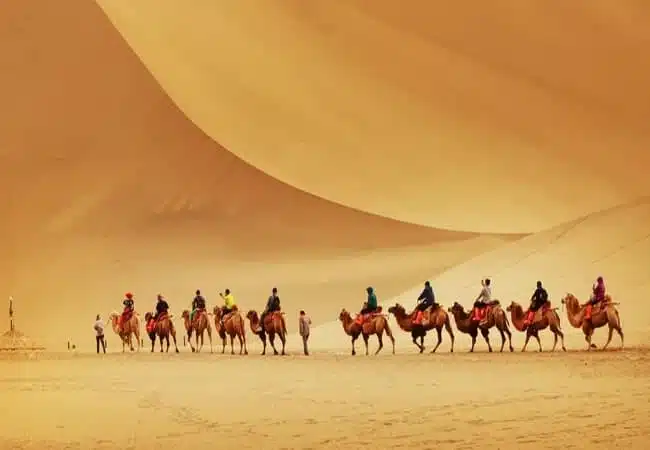
The Silk Road traverses east and west in Gansu for 3,000 miles. This road was first broken for politics and trade, but it unintentionally brought convenience to the spread of religion and art. Dunhuang County, which was established in the Western Han Dynasty, became the earliest place to bathe in the light of Buddha. With the prosperity of the Silk Road, grotto art has also been developed here. The Dunhuang Grottoes is the general term for Mogao Grottoes, West Thousand Buddha Caves, Yulin Grottoes, East Thousand Buddha Caves, Five-Temple Grottoes, One-Temple Grotto and Changma Grottoes.
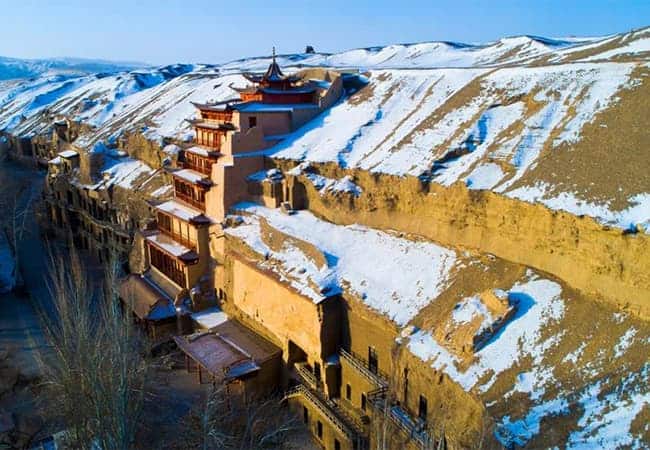
The first stop of Dunhuang Grottoes is naturally Dunhuang Mogao Grottoes. Excavated in the second year of Qin Jianyuan and built for thousands of years, Mogao Grottoes has become a treasure house of oriental art. It is recommended that you spend one or two days appreciating the exquisite murals and statues in the open caves. When you come to Mogao Grottoes in the off-season, you can not only visit more caves (from 8 in the peak season to 12 in the off season), but also visit special caves that are usually not open to the public during the peak season.

The West Thousand Buddha Cave is located about 60 kilometers west of the Mogao Grottoes. It is the earliest excavated one in the Dunhuang Grottoes, and the style of flying in different periods is also different. After seeing the spectacle of Mogao Grottoes, many people will give up visiting here, but for grotto lovers, the West Thousand Buddha Cave is still a stop that should not be missed.
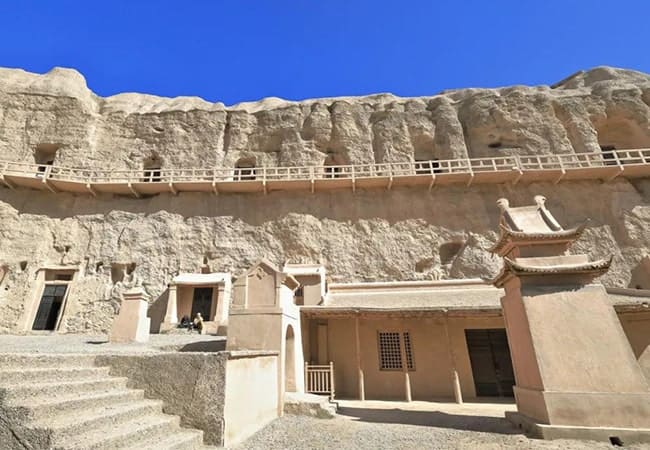
On the west of Dunhuang, you will come to Guazhou to visit the Yulin Grottoes, known as the “sister cave” of Mogao Grottoes. During the decline of Mogao Grottoes from the Western Xia to the Yuan Dynasty, Yulin Grottoes was fortunate to preserve the wonderful chapters of the late Dunhuang Grottoes. The two warp painting murals in Cave 25 can be called mega-macro.
>> Off season visit guide:
Opening hours & fares
Mogao Grottoes: From December 1st to March 31st of the following year, 9:00 ~ 17:30. Tickets are 140 yuan per person per time (Mogao Grottoes 90 yuan + Mogao Number Exhibition Center 40 yuan + The transportation fee is 10 yuan(round trip)).
West Thousand Buddha Caves: From November to April the next year, 9:00 ~ 17:00. Tickets are 30 yuan including explanation.
Yulin Grottoes: From November to April, 10:00 ~ 17:00. Tickets are 40 yuan including explanation.
Visit the special caves
Mogao Grotto Special Caves: Starting from July 1, 2020, the number of special caves will be changed to 12. The ticket price of the special caves will be subject to a new charging standard: the 156th, 159th, 217th, 254th, and 322nd caves are 300 yuan per person. Caves 45, 57, 158, 220, 275, and 285 are 500 yuan/person, and Cave 465 is 900 yuan/person. Cash only.
Yulin Grotto Special Caves: Starting from July 1, 2020, the second and fourth caves are 300 yuan/person, and the second and 35th caves are 500 yuan/person.
# Hexi Corridor Line #
Slices of grotto history
Bingling Temple Grottoes, Tianti Mountain Grottoes, Wenshu Mountain Grottoes
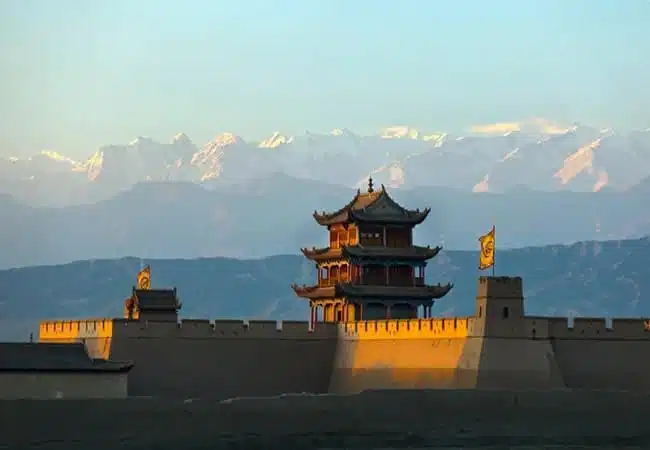
Around the 1st century AD, Buddhism was introduced to China along the Silk Road, and the cave temples originating from India were also introduced then. In the Hexi Corridor, which must be passed through, Buddhists excavated scattered cave temples. We can almost see a history of the development of Chinese grottoes on this main transportation road that has lasted for more than two thousand years. Today, the opening of the train between Lanzhou and Dunhuang connects Wuwei, Zhangye, Jiuquan and other places, making it easier to travel to the Hexi Corridor Grottoes.

Depart from Lanzhou to the Bingling Temple Grottoes in Liujiaxia. In Grotto 169 above the cliff, you can see the earliest Western Qin inscriptions. When admiring the grottoes, except for looking at the murals and statues, you should not miss the precious inscriptions. They not only provide an accurate dating basis for the excavation history of the grottoes, but also often retain the characteristics of calligraphy at that time.
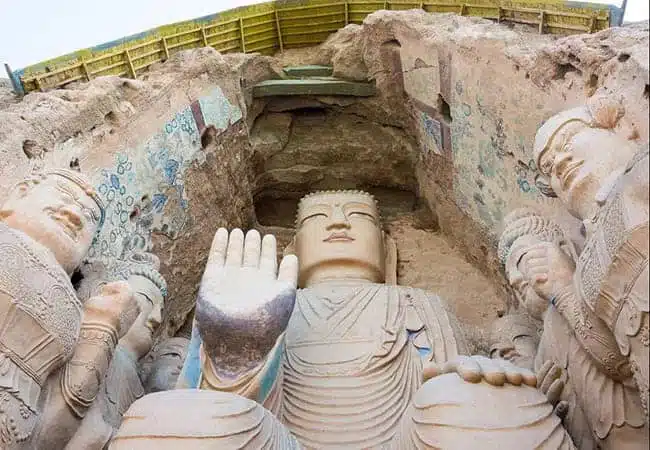
It takes more than 4 hours to reach Wuwei by high-speed train. On Tianti Mountain, about 50 kilometers south of the city, there is the Tianti Mountain Grottoes excavated in 412 AD. Mr. Subai, the leading Chinese cave researcher, visited the Tiantishan Grottoes twice and determined that this was the “Liangzhou Grottoes” mentioned in historical records. It was the origin of the Central Plains Grottoes in China and created the “Liangzhou Model” that was widely spread later. The only remaining Daxiang cave is a typical feature of the “Liangzhou Model”.
Located in Zhangye Sunan, the Wenshu Mountain Grottoes also belong to the “Liangzhou Model”.

>> Off-season visit guide:
Opening hours & fares
Bingling Temple Grottoes: 8:30~18:00, entrance fee is 50 yuan, audio guide is 20 yuan.
Tianti Mountain Grottoes: From November 1st to April 30th of the following year, 9:00 ~ 17:30. Tickets are 30 yuan.
Wenshu Mountain Grottoes: 9:00~17:30, the entrance fee for the temple is 42 yuan, and the entrance fee for the cave is 120 yuan (including the temple).
Visit the special cave
Bingling Temple Grotto Special Caves: Among the 5 special caves, Cave 169 and Cave 172 were excavated in the Western Qin Dynasty, and the other three were excavated in the Northern Wei Dynasty. In the Special Cave 169, you will admire the six niches of the Three Saints of the West, the 11 niches of the Flying styles featured by the Western Region, and the 12 niches of and murals.
# Longdong Grottoes #
The legacy of the east silk road
Maijishan Grottoes, Wushan Shuiliandong Grottoes
Jingchuan South Grottoes, Qingyang North Grottoes, Guyuan Xumishan Grottoes
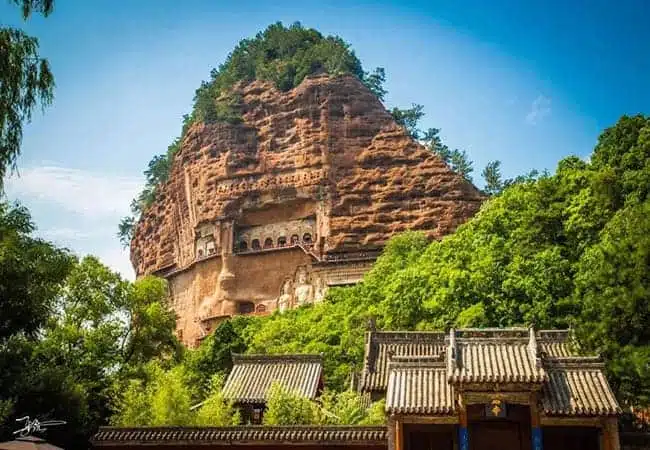
The North Road of the eastern section of the ancient Silk Road departs from Chang’an, passes through Xianyang, Binxian, Jingchuan, Pingliang, Guyuan (Ningxia), and finally crosses the Yellow River and enters the Hexi Corridor from Wuwei. This traffic artery is also a path for the spread of Buddhism, leaving a huge distribution zone of grottoes in eastern Gansu. The time spans from the Northern and Southern Dynasties to the Song Dynasty. Except for the Maijishan Grottoes in Tianshui, other grottoes are relatively modesty, but they are definitely worthy of your visit in person.
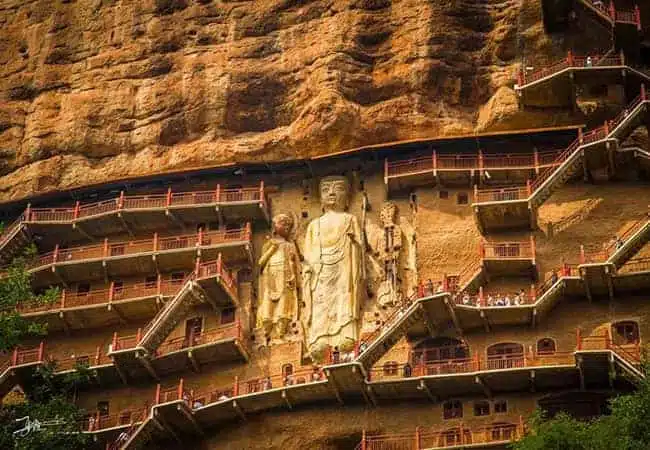
You can visit Longdong Grottoes starting from Tianshui, first go to Maijishan Grottoes to appreciate this “Oriental Sculpture Exhibition Hall”. The existing 221 cave niches are chiseled like honeycombs on the nearly vertical cliffs. More than 200 Buddhist niches have been excavated. From the more than 7,000 statues, you can clearly see the development of Buddhist sculpture art over the past thousand years.

Located in the northwestern part of Tianshui, the Wushan Shuiliandong grottoes were built in the post-Qin period of the Sixteen Kingdoms. Among them, Lashao Temple has the world’s largest open-air cliff relief Buddha.
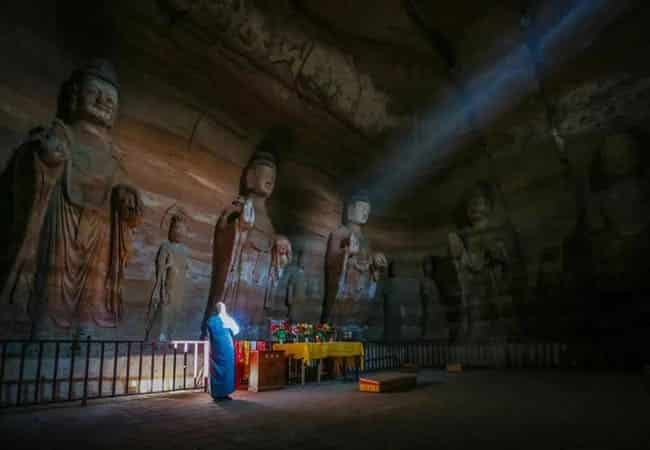
Leaving Tianshui to Pingyang, “the top city out of Chang’an in the west” on the Silk Road, the Jingchuannan Grotto Temple and Qingyang North Grotto Temple on both sides of the Jinghe River were excavated by Xi Kangsheng, the governor of Jingzhou in the Northern Wei Dynasty.
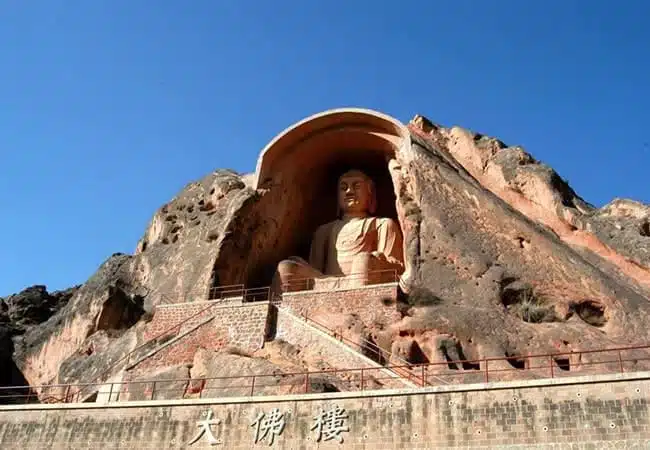
If you want to have a deeper understanding of the Seven Buddha Grottoes, about 210 kilometers northwest from Qingyang is the Guyuan Xumishan Grottoes. Cave 5 of Xumishan Grottoes is a rare Tang Dynasty Buddha, which fully embodies the high achievements of Tang Dynasty sculpture art.
>> Off-season visit guide:
Opening hours & fares
Maijishan Grottoes: From November to April the next year, 8:30 ~ 18:00, tickets are 90 yuan.
Wushan Shuiliandong Grottoes: 9:00~18:00, entrance fee is 30 yuan, battery car is 10 yuan/round trip.
Jingchuan South Grotto Temple: 8:00~18:00, tickets are 20 yuan.
Qingyang North Grotto Temple: From November to April the next year, 9:00 ~ 16:30, tickets are 30 yuan, and explanations are 50 yuan.
Guyuan Xumishan Grottoes: 8:00~18:00, entrance fee is 48 yuan, explanation is 80 yuan
Visit the special cave
Maijishan Grottoes Special Caves: There are 15 special caves in the West Cliff, which cost a lot (400 yuan for Cave 127, Cave 133, Cave 135, 300 yuan for Cave 43, Cave 44, Cave 62, Cave 74, Cave 76, Cave 78, Cave 102, Cave 115, Cave 121, Cave 123, Cave 142, Cave 155). If you are a student of an art college, the price is quite affordable, only 25-30 yuan per cave. Note that as long as you purchase a ticket for one of the special caves, an instructor will accompany you up the mountain.
# Introduction to Grottoes #
When visiting Mogao Grottoes, the instructor will usually start from the time when a cave was excavated, and then talk about its shape, what statues are in the cave, and what themes of the surrounding murals are, and then introduce the most colorful statues or mural content in detail. If you want to explore a cave yourself, you can also start to appreciate it from these points.
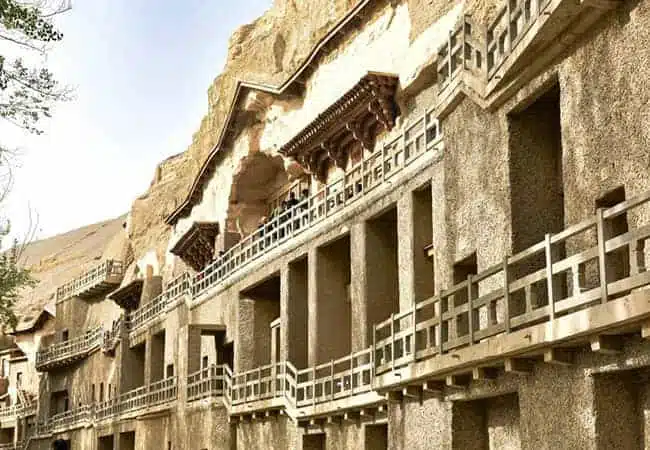
Shape of the Grottoes
The shape of grottoes is generally divided into Zen caves, central tower column caves, palace caves, Nirvana caves, Seven Buddha caves and big statue caves. The most common ones are, the central tower column caves, also called “tower temple caves”, which is originated from India. It is an earlier cave shape, such as Mogao Caves 254 and 288.

The temple cave, a more popular cave shape in the later period, is similar to the main hall of a Chinese Buddhist temple. There are statues on the front wall, and the other three sides are usually painted with murals. There is a relatively spacious space for practitioners to worship Buddha, such as Mogao Grottoes 275 and 249; the Daxiang Cave, which appears in most grottoes. A seated Maitreya Buddha statue is carved in the huge cave. There are bright windows on the top or both sides of the cave wall for lighting. There are wooden cave eaves or pavilions to protect the big statue, such as Cave 130 of Mogao Grottoes.
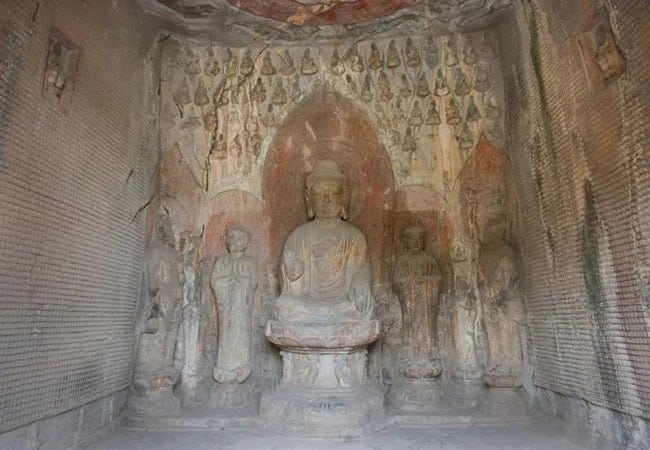
Statues
The statues in the grottoes are generally a combination of one Buddha, two Bodhisattvas, two disciples, and two protectors. There are also combinations of two Buddhas, three Buddhas, five Buddhas, and seven Buddhas. The shapes of Buddha and Bodhisattva are slightly different in each period, but in general, the image of Buddha is the tallest, with a bun and white hair, wearing a full-shoulder or right-shouldered coat, and basically no ornaments. The Bodhisattva is relatively gorgeous, wearing a crown, celestial robes, and silk on her shoulders, wearing necklaces, arm rings, bracelets and other ornaments, and holding different instruments.
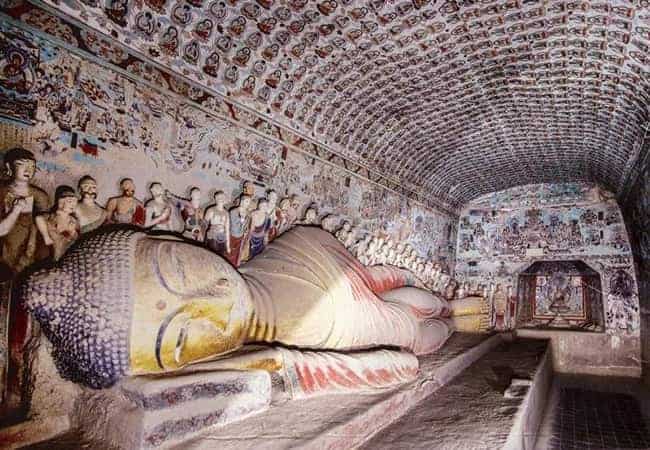
Murals
The common layout of grotto murals is to draw a highly decorative alga well on the top of the cave. The upper part of the four walls is the heavenly musical performance that goes around the cave. The lower part is a portrait of a king, a protector, or a supporter that goes around for a week. The theme mural paintings can be divided into portrait paintings, sutra paintings, bonsai, karma, and Buddhist story paintings.
